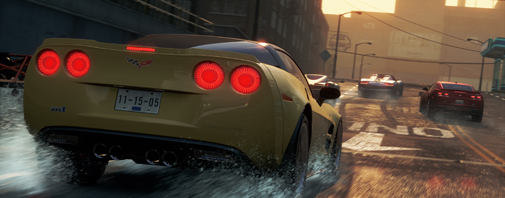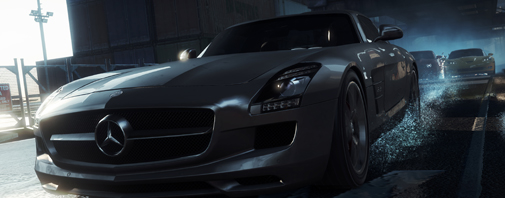After the riprorious success of the other mid-90′s Need for Speed reboot Hot Pursuit and the subsequent disappointing sludge that was The Run, a shakeup of the entire franchise was in order.
As creators of the only decent Need for Speed game in years, earlier this year Criterion took over all development of future Need for Speed titles. Prior to this, Criterion racers were either Burnout or forgettable Dreamcast outings. How do you make a Need for Speed game that redefines itself without veering too far into Burnout territory? You meet it half-way. Most Wanted feels like a seismic shift, more like the HMS NFS has finally gained a weathered old sea dog to give it some sense of direction; Paradise City.

The way cars are earned and driven has been completely overhauled, no longer do you simply started with a Vauxhall Corsa and trudge your way towards a Lamborghini Aventador, all cars bar the ’10 Most Wanted’ are available as soon as they are discovered and jacked, meaning if you can find it, you can drive it. This represents a fundamentally more open and inviting game structure which doesn’t punish newcomers or casual players.
Hopefully this framework still lends itself towards a sense of progression, rather than individual cars being the aspirational goals of a gamer, tweaks and tuneups of existing cars, as well as the 10 unlockables. Each car has a set of specific races and events which unlock mods for that specific car, allowing both upgrades but also tweaks to particular driving styles or events.
Billboards now represent something more than a mere smashable collectable, the racer who attains the furthest jump on each will have their face and Fairhaven license emblazoned on it for all to admire; doing away with the mugshots of Burnout Paradise in an attempt to reduce the amount of flip-off cocks for a 3+ rated game.

Checkpoints also now appear along the most ‘logical’ path towards the finish, straying off this path doesn’t necessarily punish the racer, checkpoint will adjust to suit your trajectory and serves as a much needed point of reference mid-race, addressing the key criticism of Paradise, the need to constantly map-check. Now when events end, you continue fluidly into the world rather than being captive in DJ Atomika’s hideous forced stasis until the event finishes.
Further tweaks have been made to the Paradise formula, top speeds on given roads are measured by speed cameras, a more logical means of measuring competitive speeds. Times and vehicle types can also be explored by pulling up to cameras, so more detail is available to those who seek it, whilst still keeping the interface lean and uncluttered. Easydrive also returns allowing quick mod selection, including the inevitable Kinect support which according to Criterion producer Matt Webster, is “faster than d-pad”.
Multiplayer is again different to previous NFS games, taking the fluidity of Burnout model in the creation of Speedlists, a collection of 5 events/races, some of which individual and some collaborative, seamlessly played back-to-back around Fairhaven, with the winner being declared Most Wanted of the given Speedlist.

The overarching means of progression are Speed Points (SP) which both drive position on Most Wanted list between friends and levelling up. SP carries over between consoles, iPhone, Android, Vita, so once you’re bored of the game on the console and fancy some fresh air, you can play a slightly lower-grade version on-the-go.
The Most Wanted staple, the police, are an “ever-present character” in Fairhaven, occasionally rearing their heads during races and often turn up just after. As your heat level rises, police become more resourceful in utilising spike strips and, if Most Wanted follows the GTA model, employing the full force of the US Army. The rozzers will follow you throughout the huge open world or Fairhaven until evaded, which can be attained through cooldown spots, straight-line speed, line of sight and the fan favourite, sheer brute force.
The main question Most Wanted raises is that what does the future hold for Burnout? Especially with such a solid game borrowing from both sides to create a thoroughly enjoyable and robust experience. Webster may have categorically denied that Most Wanted is the end of Burnout, it’s been 4 years since the last Burnout game -Crash! simply doesn’t count- and I can’t see a future other than through some sort of hideous alternating years model which inevitably harms both series in the long term.
Need for Speed: Most Wanted is the logical convergence of two franchises into one by the same developer, taking the fun and bombast of Burnout with the tension and tightness in controls of Need for Speed, having more than enough potential to be the very Need for Speed title to date.
As creators of the only decent Need for Speed game in years, earlier this year Criterion took over all development of future Need for Speed titles. Prior to this, Criterion racers were either Burnout or forgettable Dreamcast outings. How do you make a Need for Speed game that redefines itself without veering too far into Burnout territory? You meet it half-way. Most Wanted feels like a seismic shift, more like the HMS NFS has finally gained a weathered old sea dog to give it some sense of direction; Paradise City.

The way cars are earned and driven has been completely overhauled, no longer do you simply started with a Vauxhall Corsa and trudge your way towards a Lamborghini Aventador, all cars bar the ’10 Most Wanted’ are available as soon as they are discovered and jacked, meaning if you can find it, you can drive it. This represents a fundamentally more open and inviting game structure which doesn’t punish newcomers or casual players.
Hopefully this framework still lends itself towards a sense of progression, rather than individual cars being the aspirational goals of a gamer, tweaks and tuneups of existing cars, as well as the 10 unlockables. Each car has a set of specific races and events which unlock mods for that specific car, allowing both upgrades but also tweaks to particular driving styles or events.
Billboards now represent something more than a mere smashable collectable, the racer who attains the furthest jump on each will have their face and Fairhaven license emblazoned on it for all to admire; doing away with the mugshots of Burnout Paradise in an attempt to reduce the amount of flip-off cocks for a 3+ rated game.

Checkpoints also now appear along the most ‘logical’ path towards the finish, straying off this path doesn’t necessarily punish the racer, checkpoint will adjust to suit your trajectory and serves as a much needed point of reference mid-race, addressing the key criticism of Paradise, the need to constantly map-check. Now when events end, you continue fluidly into the world rather than being captive in DJ Atomika’s hideous forced stasis until the event finishes.
Further tweaks have been made to the Paradise formula, top speeds on given roads are measured by speed cameras, a more logical means of measuring competitive speeds. Times and vehicle types can also be explored by pulling up to cameras, so more detail is available to those who seek it, whilst still keeping the interface lean and uncluttered. Easydrive also returns allowing quick mod selection, including the inevitable Kinect support which according to Criterion producer Matt Webster, is “faster than d-pad”.
Multiplayer is again different to previous NFS games, taking the fluidity of Burnout model in the creation of Speedlists, a collection of 5 events/races, some of which individual and some collaborative, seamlessly played back-to-back around Fairhaven, with the winner being declared Most Wanted of the given Speedlist.

The overarching means of progression are Speed Points (SP) which both drive position on Most Wanted list between friends and levelling up. SP carries over between consoles, iPhone, Android, Vita, so once you’re bored of the game on the console and fancy some fresh air, you can play a slightly lower-grade version on-the-go.
The Most Wanted staple, the police, are an “ever-present character” in Fairhaven, occasionally rearing their heads during races and often turn up just after. As your heat level rises, police become more resourceful in utilising spike strips and, if Most Wanted follows the GTA model, employing the full force of the US Army. The rozzers will follow you throughout the huge open world or Fairhaven until evaded, which can be attained through cooldown spots, straight-line speed, line of sight and the fan favourite, sheer brute force.
The main question Most Wanted raises is that what does the future hold for Burnout? Especially with such a solid game borrowing from both sides to create a thoroughly enjoyable and robust experience. Webster may have categorically denied that Most Wanted is the end of Burnout, it’s been 4 years since the last Burnout game -Crash! simply doesn’t count- and I can’t see a future other than through some sort of hideous alternating years model which inevitably harms both series in the long term.
Need for Speed: Most Wanted is the logical convergence of two franchises into one by the same developer, taking the fun and bombast of Burnout with the tension and tightness in controls of Need for Speed, having more than enough potential to be the very Need for Speed title to date.








0 comments:
Post a Comment